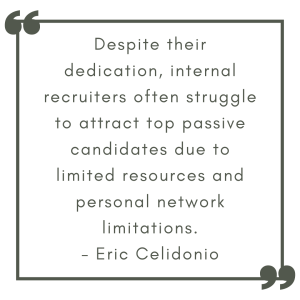Understanding these two types of searches can make all the difference in finding the right candidate
 Your job advertisement isn’t bringing in the right people. You need to staff up a new lab or department—quickly. You need a new chief scientific officer and your in-house recruiters don’t have the expertise or capacity. Do you keep hoping the same ad will work, or do you bring in outside specialists?
Your job advertisement isn’t bringing in the right people. You need to staff up a new lab or department—quickly. You need a new chief scientific officer and your in-house recruiters don’t have the expertise or capacity. Do you keep hoping the same ad will work, or do you bring in outside specialists?

With an internal search, you may be seeing the best of who’s currently available, but search firms reach out to individuals who are not actively looking. “Despite their dedication, internal recruiters often struggle to attract top passive candidates due to limited resources and personal network limitations,” says Eric Celidonio, senior managing partner of Sci.bio.
Those passive candidates are important. Most people who changed jobs in the previous 12 months weren’t actively looking for a new role, according to 2019 U.S. Census data cited by the Harvard Business Review. Senior-level candidates often prefer partnering with experienced recruiters who not only advocate for them, but bring them opportunities to help meet their career and compensation goals.
It can be helpful to broaden the search horizons by bringing in a talent acquisition (TA) agency. But should you go the contingent or retained route, and how do you know which firm to choose?
How to think about retained search
Many companies bring on retained TA firms for senior level or executive positions when the internal staff doesn’t have the time or expertise to recruit those roles on their own. Another reason? The firms keep searches confidential as they comb through their networks to identify potential candidates, without necessarily posting the job publicly.
Adam Fitzer, lead talent acquisition consultant for Edwards Lifesciences, highlights another consideration: “The key with retained search is the exclusivity piece.” Firms won’t be competing against each other to fill the role since they contract to be the sole search provider. “The majority of retained firms are seen as having the best candidates available. It can take a lot longer, but they go deeper and the candidates are more polished because of the level of the individual you’re recruiting for,” he says.

How to think about contingent search
While retained search is often used for higher-level positions, when recruiting for mid- or lower-level roles, contingent can be a good option. This is especially true when a company needs to hire multiple people for the same roles, and also when speed is an issue. “The contingent side is basically nonexclusive. And if you don’t fill the role, you don’t get paid,” says Fitzer.
Contingent firms can also be used to quickly test the market when looking at internal referrals to see if there are better candidates available elsewhere, says Adam Bloom, president of Stevenson Search Partners.
The problem with contingent searches is that companies often work with more than one firm. This can send the market inconsistent messages, and the same candidates could be approached by multiple firms. Contingent agencies may also be less motivated to help fill the role after the initial search period wears off, says Greenfield.
How search fees vary
The biggest difference between retained and contingent is that contingent firms only get paid when they fill a role. They earn a flat percentage based on the candidate’s negotiated salary—25% on average, Fitzer says. Usually, the full fee is paid 30 days after the candidate starts, but occasionally the fee is broken into 30-, 60-, and 90-day milestones.
Retained fees can be calculated on the base salary or the base plus bonus. Bloom says the industry sector tends to stick with a 30% to 33.3% fee that’s typically broken up into milestones: one-third up front, one-third when presenting the candidate slate or scheduling interviews, and a one-third “success fee” when a candidate accepts the offer.
Can you negotiate in a softer market?
With interest rate hikes in the last few years and some tightening of the corporate belt, “it’s a bit of a white-collar recession,” Celidonio explains. “When the economy or your segment sags, vendors of all kinds will respond by fighting to compete with what’s out there.”

There are creative ways to negotiate a different structure, including a flat fee, “which takes variability for the final compensation offer off the table,” Bloom says. Stevenson Search Partners has been open to that, especially if there’s an opportunity to search for multiple roles “and help build a department.” Stevenson has also taken equity in lieu of a fee when an early stage or growing company has a cash crunch and the company has promise. Bloom looks for win-win opportunities to partner.
Retained agreements can also be structured with staggered payments, giving a lower up-front percentage and more money spread out over time “so you’re not necessarily feeling the pinch as badly,” Fitzer says. Hiring companies tend to prefer a lower percentage, though, because that impacts the bottom line.
Contingent firms can also take a hybrid “container” approach, with an up-front flat fee and a contingent percentage if the position fills. Celidonio actually prefers this model, as it “offers the effectiveness of a retained search, but with reduced risk.” He adds that, “In this model, the firm is incentivized to deliver results to earn their reward, unlike in a fully retained search where you might pay two-thirds of the fee without a guaranteed placement.” Firms confident in their ability are often open to this flexible approach, he says.
What about the warranty?
“Most of the time we get it right and once in a while it turns out not to be the right fit for the candidate and the organization,” says Greenfield. In that case, the retained firm will backfill the position, depending on the agreement and how long the candidate was employed.
Bloom’s firm guarantees one year unconditionally. “If someone wins the lottery and decides to retire, or if they’re not performing, we owe you a backfill,” he says.
Contingent firms offer guarantees that tend to be shorter, usually 3-6 months. When Fitzer was a contingent recruiter, he offered a 90-day guarantee. When one of his placements left on the 89th day, he had to refund the entire fee. He adds that contracts can be structured so the firm earns the fee in milestones, and the contract can also mandate the right to backfill the role for a certain amount of time. “It’s really important to make sure you understand what kind of guarantee they’re offering and push to negotiate it up front,” Fitzer says.
How to pick a search firm
When looking for a retained firm, Fitzer advises you find one that specializes. “Make sure they’re not trying to be all things to all people,” as they need credibility when talking to the hiring manager as well as to candidates.

These experts all agree that references are vital when choosing the best search firm for your needs. Get a good feel for who will be leading your search and make sure you’d be happy spending time with them on a regular basis. “Do you feel the person will be your advocate? Will they be available when needed?” asks Greenfield. She adds that recruiting is not 9 to 5, and the recruiters should represent their clients’ interests, including being available when developments occur on nights and weekends.
Also find out their track record for placing similar leaders. Ask for related references—both for the hiring company and the talent—placed within the past two years, Greenfield recommends. “It can be helpful to have a reference for a candidate placed by the search firm to understand what the project looked and felt like from the candidate’s perspective.”

The talent acquisition process can be a long and winding road. Finding the right partner can make it easier, helping you find that needle in a haystack. It pays to do your homework, understand how and why retained and contingent firms work the way they work, and ask questions to find the best fit.








